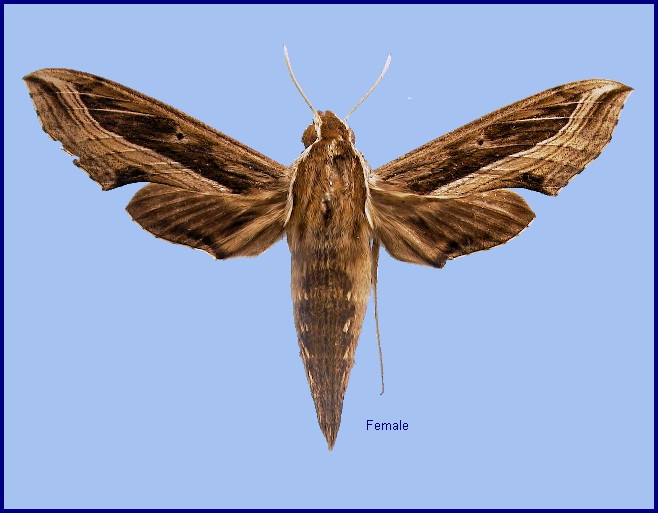
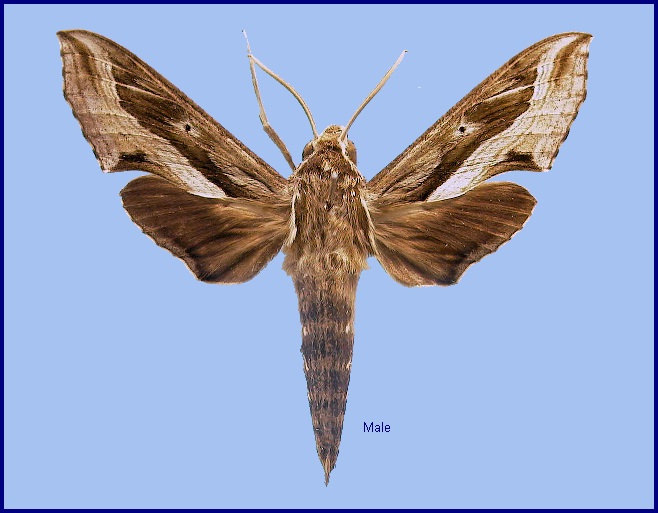
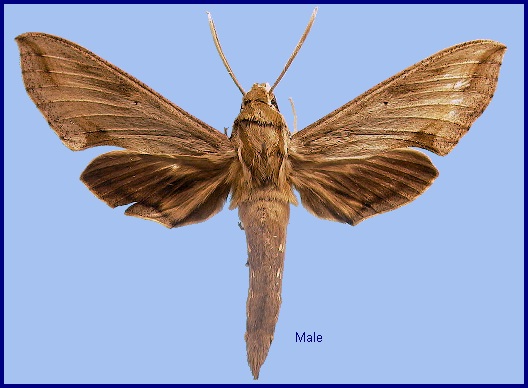
Sphinx velox Fabricius, 1793, Ent. Syst. 3 (1): 378. Type locality: "India orientali".
Synonym. Sphinx velox Fabricius, 1793.
Synonym. Sphinx vigil Guérin-Méneville, 1843.
Synonym. Panacra lignaria Walker, 1856.
Synonym. Sphinx phoenyx Herrich-Schäffer, 1856.
Synonym. Chaerocampa swinhoei Moore, 1866.
Synonym. Choerocampa yorkii Boisduval, 1875.
Synonym. Panacra griseola Rothschild, 1894.
Synonym. Panacra lifuensis Rothschild, 1894.
Synonym. Panacra pseudovigil Rothschild, 1894.
Synonym. Panacra rosea Rothschild, 1894.
Synonym. Hippotion obanawae Matsumura, 1909.
Synonym. Hippotion beddoesii Clark, 1922.
Synonym. Hippotion noel Clark, 1923.
Synonym. Hippotion tainanensis Clark, 1932.
Synonym. Hippotion taiwanensis Riotte, 1975.
Synonym. Hippotion japenum Riotte, 1994.
Note: The 'species' Hippotion obanawae Matsumura, 1909 from Taiwan is not tenable. It was first synonymized with Hippotion velox by Inoue, 1973, Bull. Fac. domest. Sci. Otsuma Wom. Univ. 9: 124. Then synonymized with Hippotion swinhoei by Riotte, 1977, Ent. Z. 87: 80. Resynonymized with Hippotion velox by Inoue, 1982, In: Inoue et al., Moths of Japan 2: 321. Treated as a species by Bridges, 1993, Cat. Fam. Gen. Spec. Sphingidae of the World: VIII. 10. Implicitly resynonymized with Hippotion velox by Moulds, 1996, In: Nielsen, Edwards & Rangsi (eds), Monographs on Australian Lepidoptera 4: 269. Reinstated as a subspecies of Hippotion velox by Heppner, 2012, Lepid. Novae 5: 33, who asserted that "The subspecies concept is that they are merely geographic labels for disjunct populations of a single species and need no specific morphological differences to be established as such. Each population surely has some differences, but geographic isolation should be the only criterion in using subspecies names". There is no scientific justification for such a subspecies definition and it is therefore rejected. Implicitly resynonymized with the nominotypical subspecies by Eitschberger, 2015, Atalanta 46: 154.
[Further details on this species in Japan, as well as photos of many stages, can be found on Digital Moths of Japan.]
Wingspan: 54--76mm. Very variable in size and pattern. Forewing upperside typically similar to Hippotion geryon but the oblique pale postmedian band narrow and crenulated between Rs4 and Cu2. However, the ground colour can be pale rosy-grey, with all pattern elements weakly visible except for the dark brown or black first and second postmedian lines (f. rosea). Alternatively, the entire forewing pattern as far as the marginal band can be overlaid by uniform pale grey, with only the discal spot visible (f. swinhoei). Intermediates between these three forms also exist. Hindwing upperside typically dark brown with a paler brown basal and tornal area and a very poorly developed postmedian band. However, the tone is very variable and when at its palest, a distinct buff or slightly rosy postmedian band is visible. Head and thorax brown, with pale lateral streaks in typical individuals; abdomen brown, with numerous dark strigae and pairs of pale lateral strigae on each segment.
Forms rosea and swinhoei can dominate insular populations (Taiwan, Christmas Island, many Pacific Island groups), with typical moths being almost or entirely absent.
In the male genitalia, uncus gradually narrowed, as in Hippotion geryon, but apex sharply sinuate with acute angles. Gnathos abruptly narrowed distally into a slender, pointed, triangular, medial process that is somewhat curved dorsad. Harpe slender, apex somewhat dilated and spatulate. Phallus apically with a row of teeth on the right side and a shorter, subapical row on the left. In the female genitalia, ostium bursae narrow, with a weakly sclerotized, rather prominent lobe on each side.
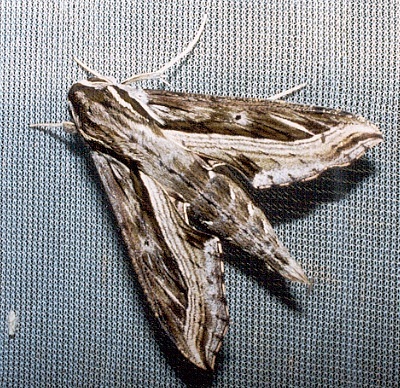
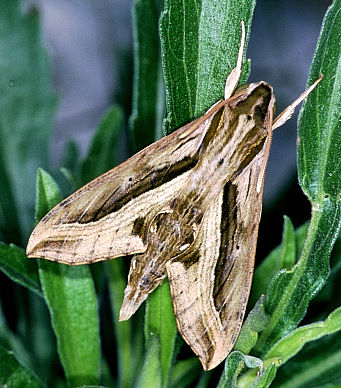
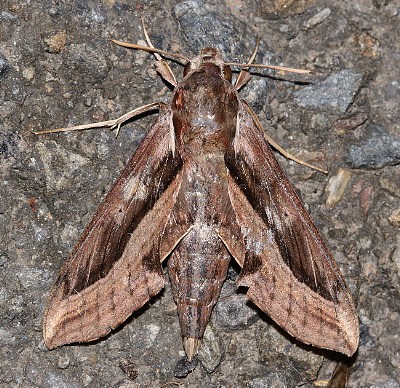
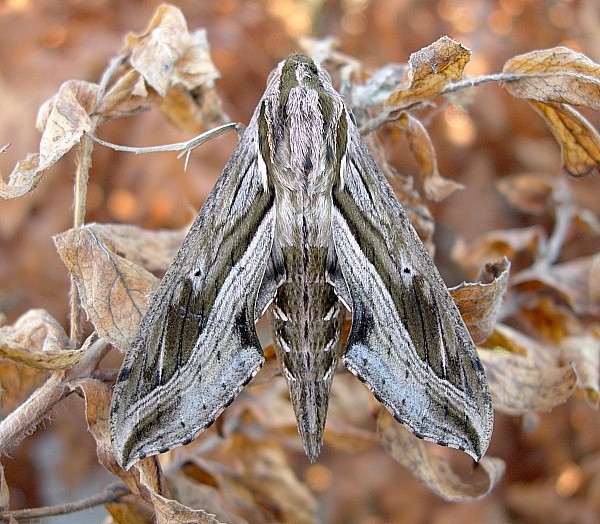
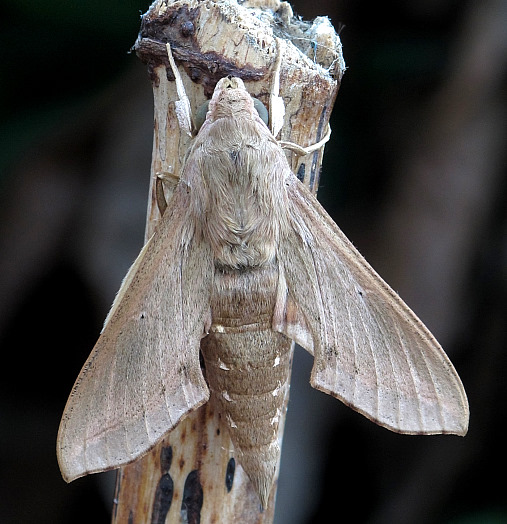
The moth has been caught at flowers after dark, but does not appear to be attracted by light (Bell & Scott, 1937).
China: 29.v (Hong Kong); 19.x (Yunnan). Taiwan. iii-v (Kaohsiung Hsien); iv (Kaohsiung Hsien; Pingtung Hsien); vii (Pingtung Hsien); viii (Kaohsiung Hsien). Japan: 18-24.iv (Ryukyu Archipelago); 12.x (Ryukyu Archipelago).
OVUM:
LARVA: Full-fed 60mm, width 12mm, horn 7mm. According to Bell & Scott (1937), in the first instar yellowish-white, becoming green after feeding, with a short, straight, black horn.
In the final instar, head small and round; clypeus triangular, one-half length of head; false clypeus with apex acute; labrum one-half length of clypeus, narrowing frontad; ligula as long as labrum, broader than front margin of labrum, kidney-shaped, the lobes rather broad; cutting-edge of mandible slightly waved. Surface of head slightly shiny, smooth with very minute hairs. Body dull and smooth; segments 4 and 5 very swollen. Horn straight, rather short and stout, evenly tapering, dull, and covered with minute, conical, setiferous tubercles.
There are green and dark (brown) forms. In the green form, head and body bright grass-green, body with a transverse row of obscure yellow dots along each secondary ring. There is a narrow, neutral tinted dorsal stripe from segment 6 to base of horn, darker at the front margin of each segment. A longitudinally oval eye-spot occurs dorso-laterally near the front margin of 6, which is yellow irregularly centred with plum-colour. Horn violet, paler at base, darker at tip. True-leg basal segments whitish, second and third dark purple, claw black; prolegs green, feet soiled whitish. Spiracles narrowly oval, whitish with a broad, diffuse brown band across the middle (Bell & Scott, 1937).
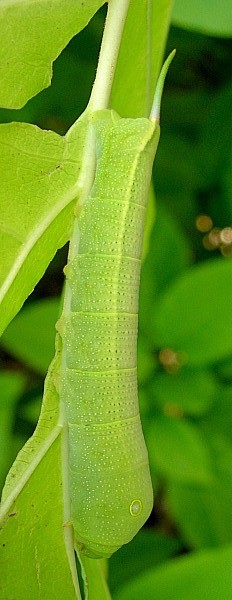
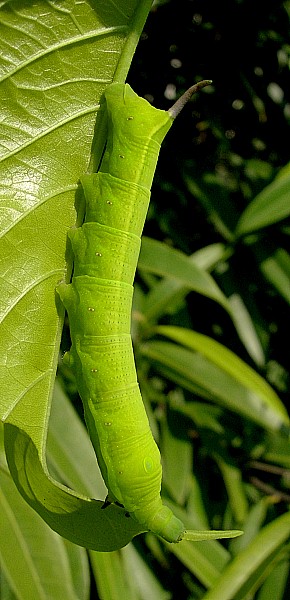
In the dark form the head is smoky-brown; body yellowish-white with short, black or dark brown, parallel lines on each secondary ring; a narrow black dorsal stripe on 2 to 4, appearing only as a black spot at the front margin of the remaining segments. There is a broad, pale yellow, dorso-lateral stripe on 2 to 4 appearing again on 6 to 11 as a short length only on each segment, continuous again on 12 to base of horn. The eye-spot on 5 with dark brown centre, bordered narrowly with first pale yellow, then black. There are pale, narrow, oblique stripes on 6 to 11, and a similar subspiracular stripe, the angles between this stripe and the oblique stripe filled in with brown speckled with white. Horn blackish-brown; the tip and sides of base paler.
Both green and brown forms are illustrated by Eitschberger & Ihle (2019).
In the last instar the larva rests on the stem and hidden among the leaves. In the resting position the horn is held horizontally, but when the larva is moving it is bent forwards over the dorsum at each forward movement of the claspers (Bell & Scott, 1937).
PUPA: 48mm, width 11 mm. Bone-coloured, closely spotted and speckled with brown and some black dots. Tongue-case brown, paler basally, the edge whitish; bases of legs and veins of wings dotted with black; shoulder fuscous; abdomen with a broad greenish, dorsal stripe; a narrow, interrupted, black ventral stripe; a broad, interrupted, black latero-ventral stripe; spiracles, and a patch round each and cremaster black. Tongue-case projecting slightly in front of head, more projecting ventrally, semicircular in a side-view, narrow, its edge finely channelled. Antenna slightly shorter than fore leg, which reaches to one-third length of wing-case, mid-leg to one-half; a short, narrow coxal piece. Surface slightly shiny, head, thorax and wing-ease superficially shagreened; front bevel of segment 9 with a series of ridges -parallel with the margins of the bevel, bevels of 10 and 11 tuberculate; the surface of the pupa round the spiracles of 8 to 10 striate; 13 and 14 pitted as well as shagreened. Spiracle of 2 a narrow slit, the hind margin of 2 slightly raised in front of it, the front margin of 3 thickened behind it. Remaining spiracles elongate-oval, flush, central slit with a narrow rim. Cremaster triangular, ending in two long, nearly parallel shafts, each shaft with two minute hooks at tip and one on each side at the middle; lower surface of cremaster deeply hollowed (Bell & Scott, 1937). Illustrated by Eitschberger & Ihle (2019).
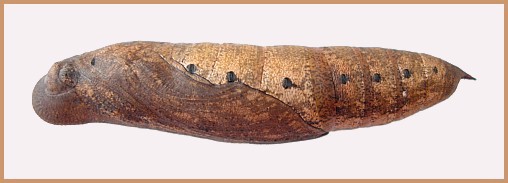

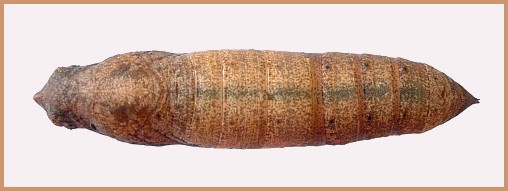
Larval hostplants. Many species in the genera Pisonia, Ceodes, Alocasia, Brassica, Ipomoea and Morinda.
On Taiwan recorded from Pisonia aculeata and Ceodes umbellifera [syn. Pisonia alba; syn. Pisonia umbellifera] (Nyctaginaceae).
In India on Pisonia grandis [syn. Pisonia morindifolia] and Pisonia aculeata; in Bangkok, Thailand, on Ceodes umbellifera (Birdlime Tree). These shrubs, known locally in India as 'lettuce trees' owing to the leaves resembling those of the lettuce, are grown in gardens in Bombay, Belgaum and other places (Bell & Scott, 1937).
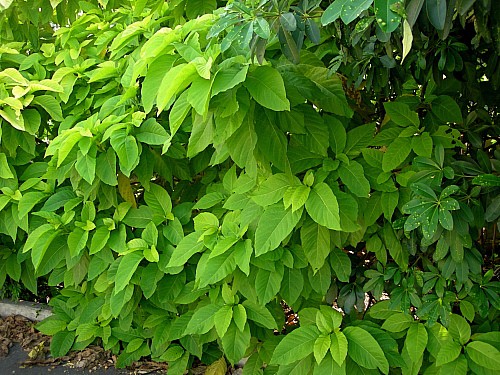
China: Yunnan (Yingjiang, 1680m); Hong Kong (Lantau Island); Guangxi (Longshen); Hainan (Xisha Islands/Paracel Islands/Hoŕng Sa Archipelago; Haikou).
Taiwan: Kaohsiung Hsien (nr. Tuona, 12km SE of Shanping, 750m; Shanping, 640m; Liukuei; nr. Maolin, 1300m); Pingtung Hsien (Kenting); Nantou Hsien (Chichi; Tatachia, 2650m; Lushan Spa; Houfuanshan); Taitung Hsien (Chihpen); Taipei Hsien (Wulai); Taichung Hsien (Lishan); Chiayi Hsien (Alishan); Hualien Hsien (Antung; Hungyeh); Orchid Island/Botel Tobago.
Japan: Ryukyu Archipelago (Ishigaki-jima; Okinawa).
Virtually the entire Oriental and Australasian biogeographical regions, i.e. from India to Australia, New Caledonia and Fiji, and north to Hong Kong, Taiwan and southern Japan. Also firmly established on the island of Guam, along with several other sphingidae.
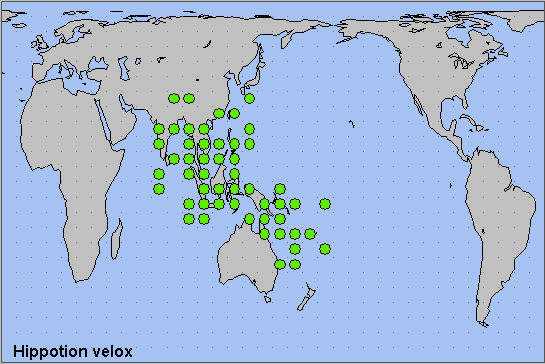
 Return to Sphingidae of the Eastern Palaearctic species list
Return to Sphingidae of the Eastern Palaearctic species list